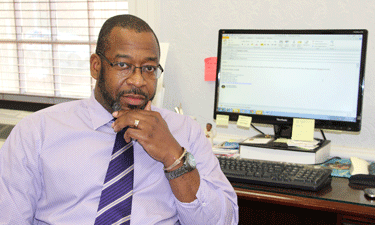 Don’t tell Ben Johnson there’s nothing for kids to do at Louisville Metro Parks & Recreation in Kentucky. The assistant director of recreation bristles at the suggestion that his department is lacking in programming for youth, not to mention adults and seniors. In his 10 years with Louisville Metro Government — eight and a half in the Office of Youth Development and the past year and a half with Metro Parks — he’s developed programming at 12 community centers, two art centers, two senior centers and one year-round pool, and he’s preparing to take on four more pools this summer. Johnson also takes pride in building strong connections throughout his community between residents, municipal leaders, police and kids. Below, he gives us a taste of the sort of commitment it takes to facilitate effective, impactful programming.
Don’t tell Ben Johnson there’s nothing for kids to do at Louisville Metro Parks & Recreation in Kentucky. The assistant director of recreation bristles at the suggestion that his department is lacking in programming for youth, not to mention adults and seniors. In his 10 years with Louisville Metro Government — eight and a half in the Office of Youth Development and the past year and a half with Metro Parks — he’s developed programming at 12 community centers, two art centers, two senior centers and one year-round pool, and he’s preparing to take on four more pools this summer. Johnson also takes pride in building strong connections throughout his community between residents, municipal leaders, police and kids. Below, he gives us a taste of the sort of commitment it takes to facilitate effective, impactful programming.
Parks & Recreation magazine: Talk a bit about the community centers under Louisville Metro Parks.
Ben Johnson: Our 12 traditional community centers offer a wide array of programming for all age groups. We truly cover the spectrum from A (Adapted Leisure programming) to Z (Zumba). We are very intentional in saying we have community centers and not recreation centers because when most people hear the term “recreation center,” they only think of a place for youth. While we offer a lot of recreation programs, we also have age- and gender-specific programs, programs for seniors, art-based programming, job-training programs, health and fitness programming, etc.
P&R: Community relations — in particular, between residents and the police — have featured heavily in recent news. In what way do you feel community centers help to foster positive relations between community members and, possibly, between residents and municipal leaders including police?
Johnson: Our division has a great working relationship with the police and we are trying to make sure that spreads throughout the community…We asked for and have seen officers just stop by the [community] centers from time to time. Officers have participated in our Fun Day/Field Day activities with more than 400 youth from across the city — even running (in uniform!) in a race. We are currently looking to revive a conversation series at the community centers geared specifically toward teens. We did this years ago, not in response to an incident, but because we thought it was a good idea. Obviously now is a good time to bring that back.
P&R: What do you say to folks who are looking for ways to keep their kids occupied during out-of-school hours, and why do you feel park and recreation programs are well-positioned to encourage positive activities and attitudes in youth?
Johnson: Persons who say there is a lack of programs for youth are terribly misinformed…Our community centers are uniquely positioned to provide positive, constructive activities because we have very few limitations. We are not singularly focused on one part of the community, education, sports, job training, an age group, race, ethnicity, etc. We are open to and willing to work with any and all.
P&R: What advice would you give to other park and rec professionals looking to foster better community relations at their agencies?
Johnson: Be open. Be honest. Be fearless.
At this year’s NRPA conference there was a button that was a red circle with a line through it that said, “But we’ve always done it that way!” I have that sign up in all of our centers — we have to get away from that type of thinking, personally, professionally and as a community. We have to be open to new ideas (or bringing back old ones) while being honest about what we can or cannot do…Lastly, it’s OK to be wrong, make a mistake or even fail. There are occasions when that is the best way to learn. We have to model some of the behaviors we are trying to teach. I wonder if sometimes the “fear of failure” might not be more accurately described as the “fear of success.”
Samantha Bartram is the Associate Editor of Parks & Recreation magazine.

